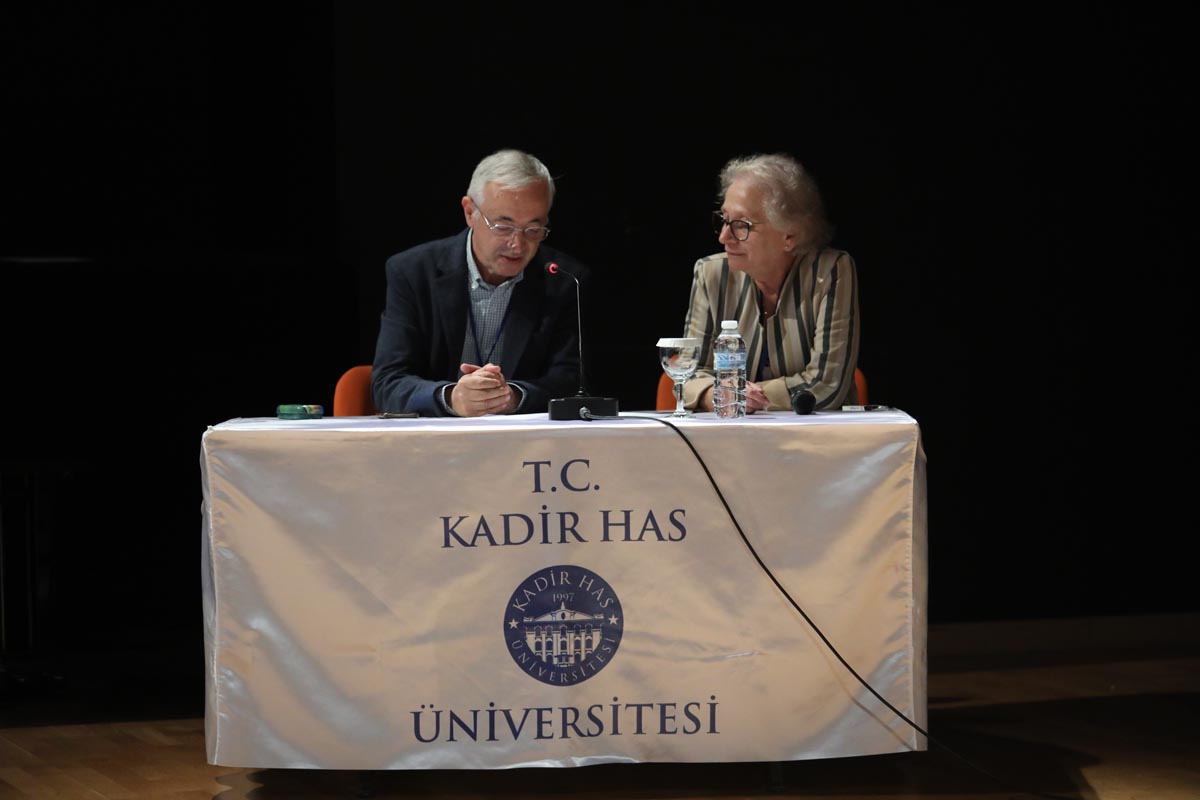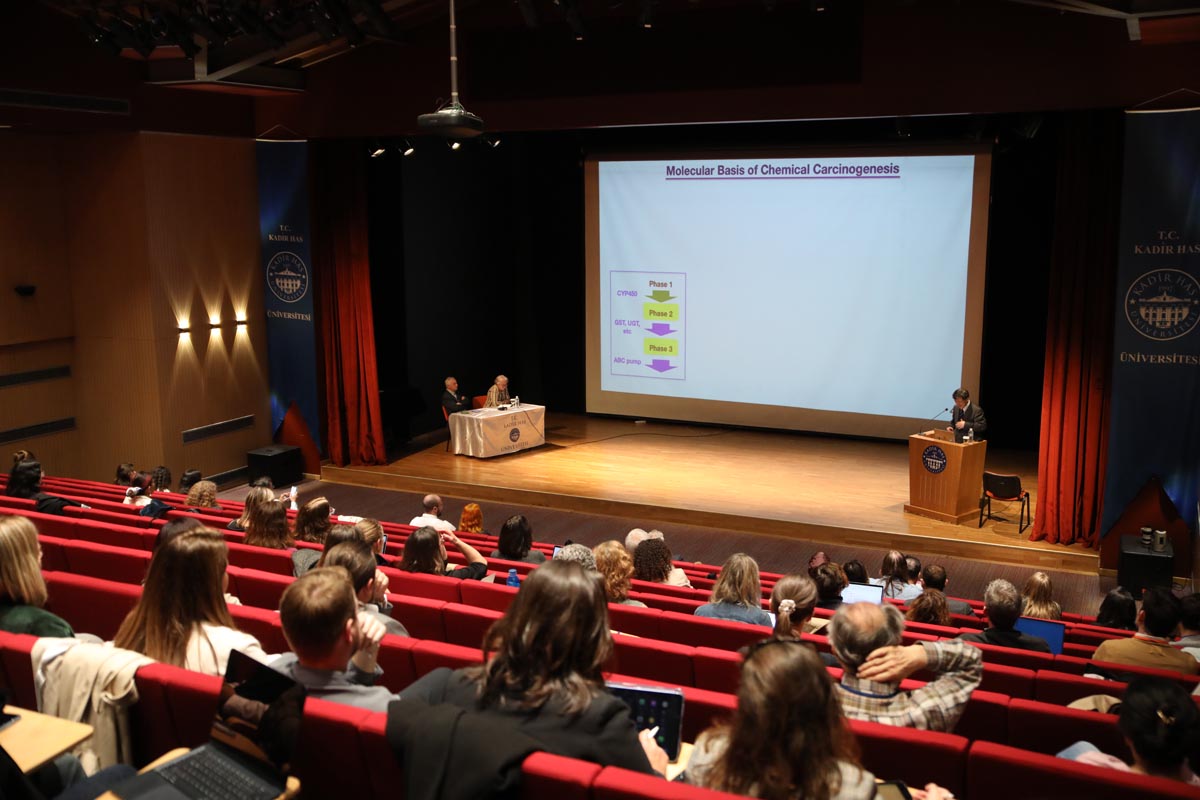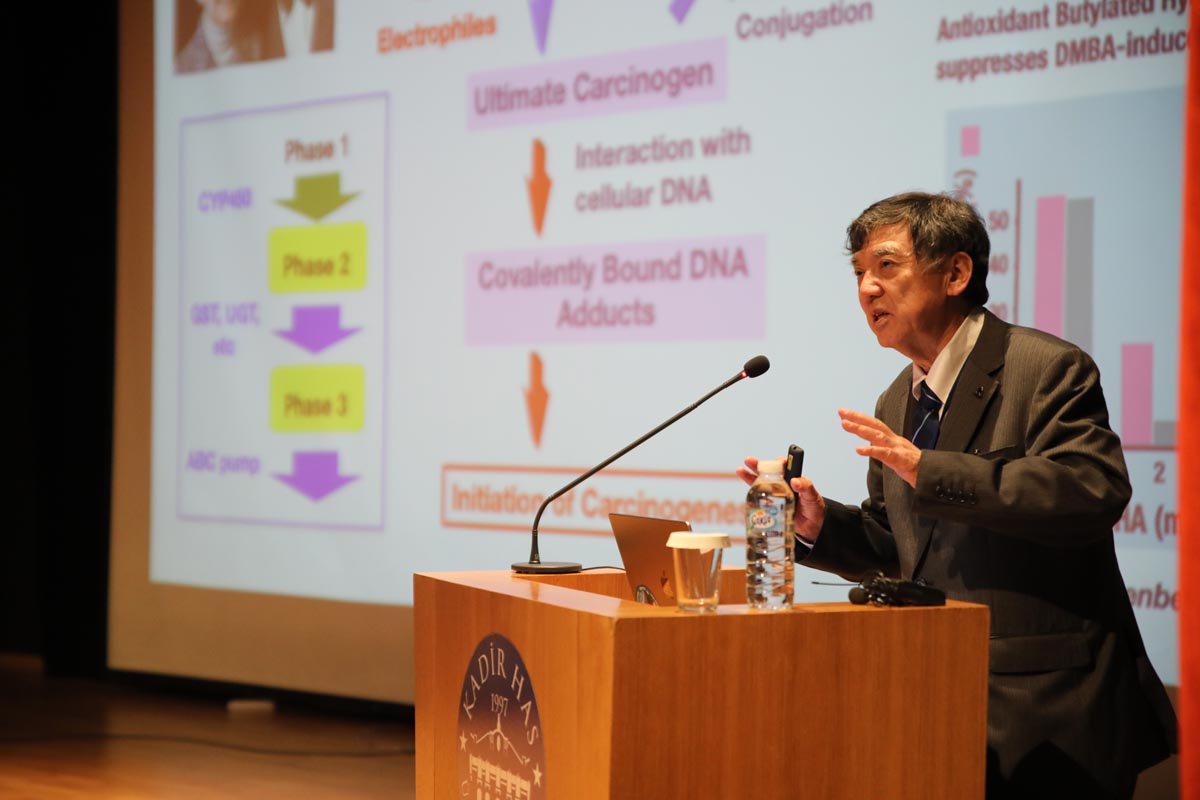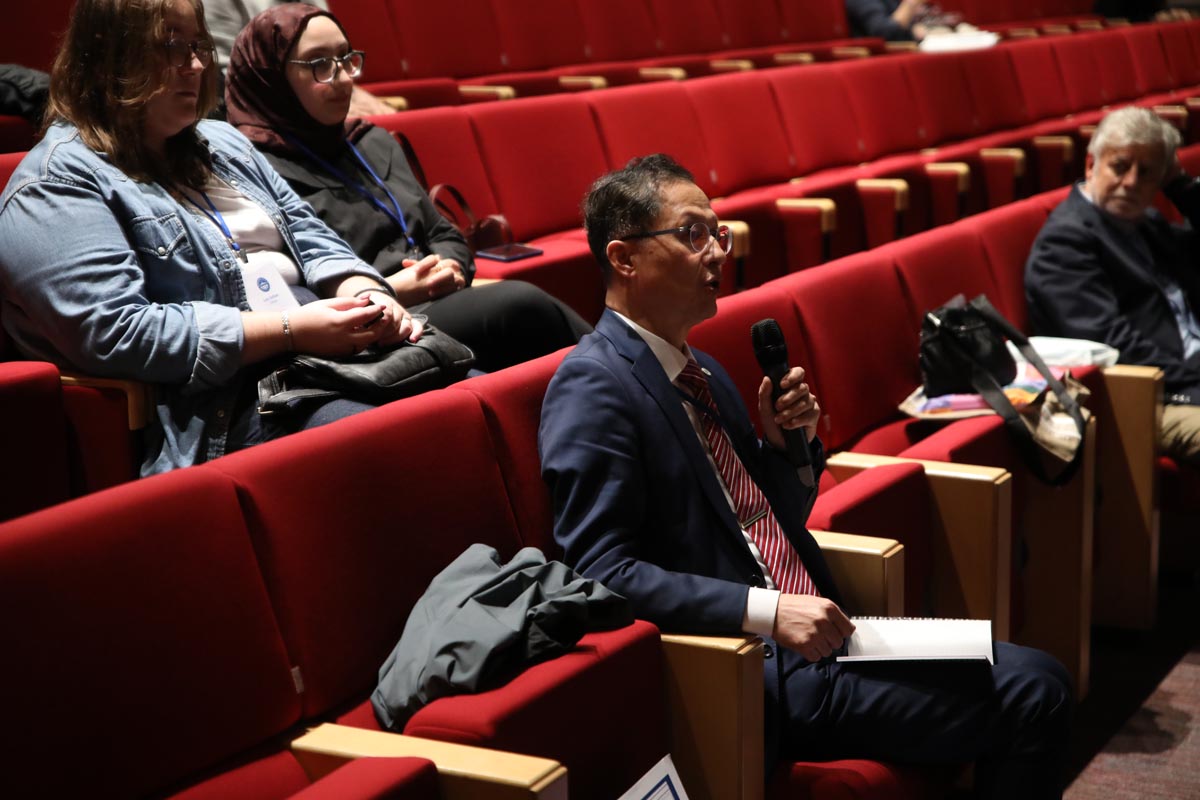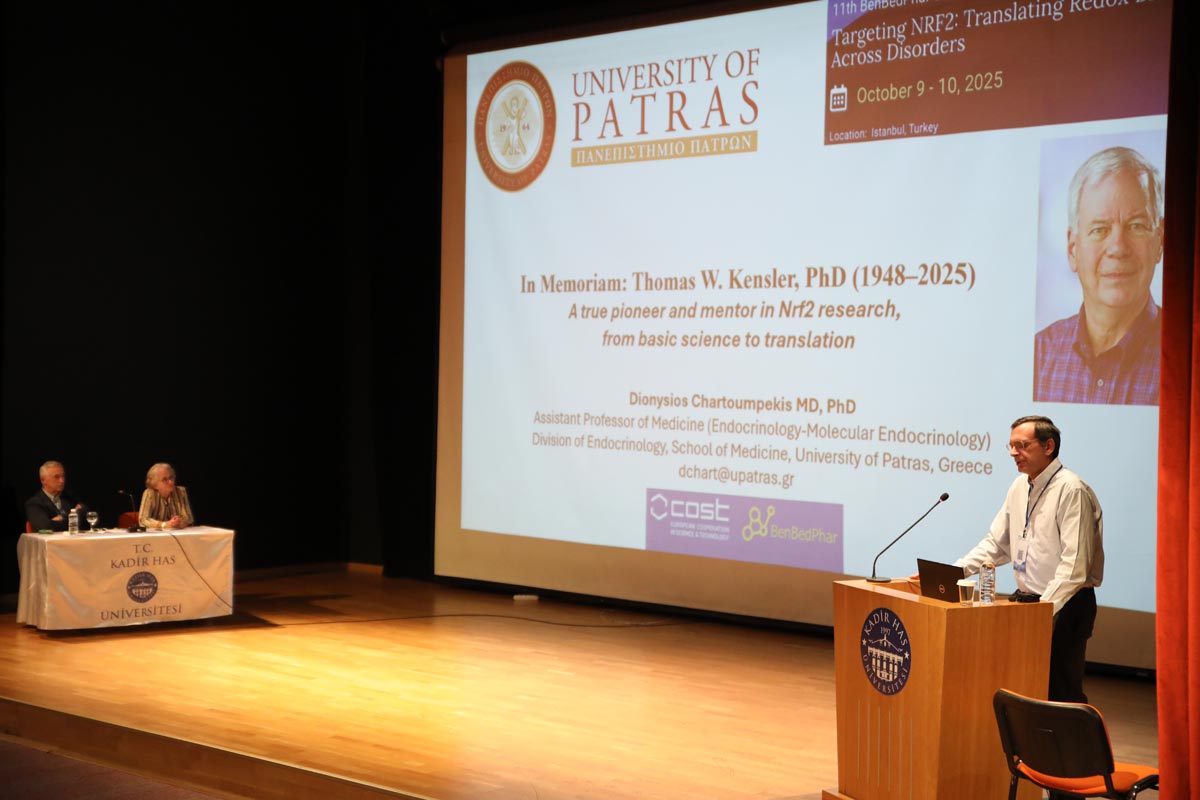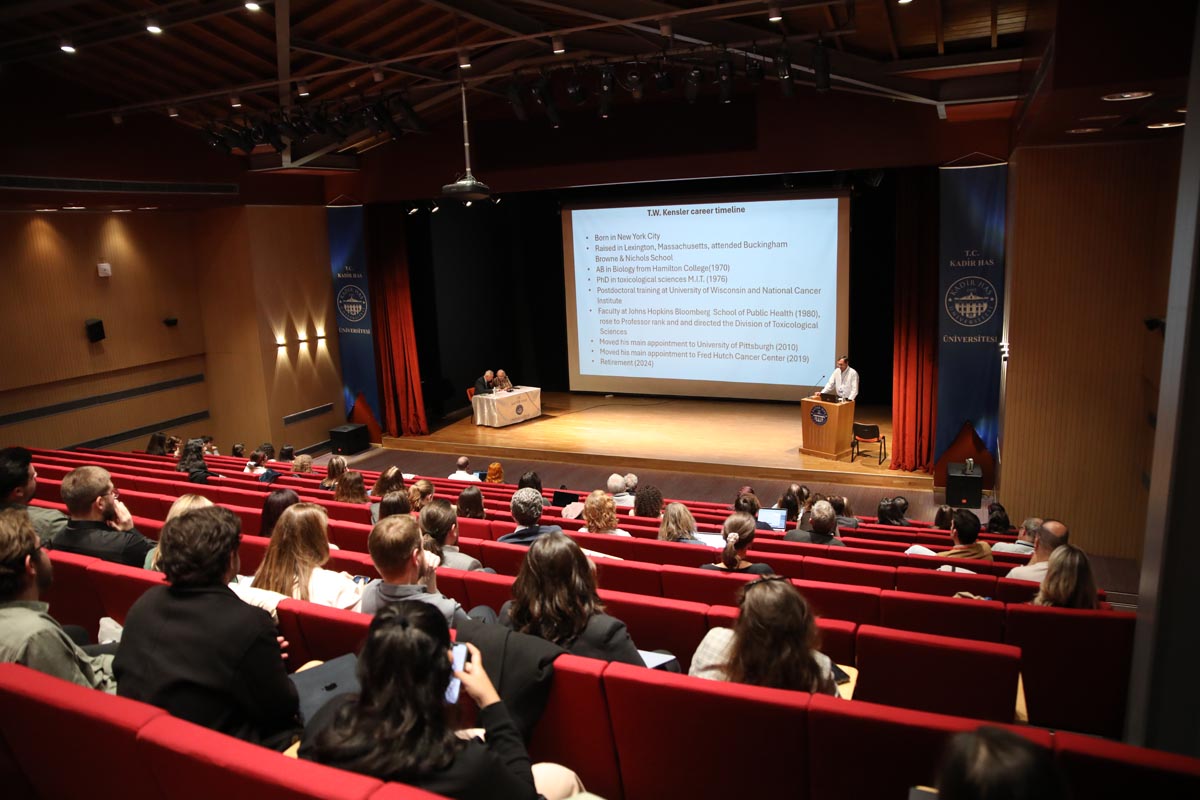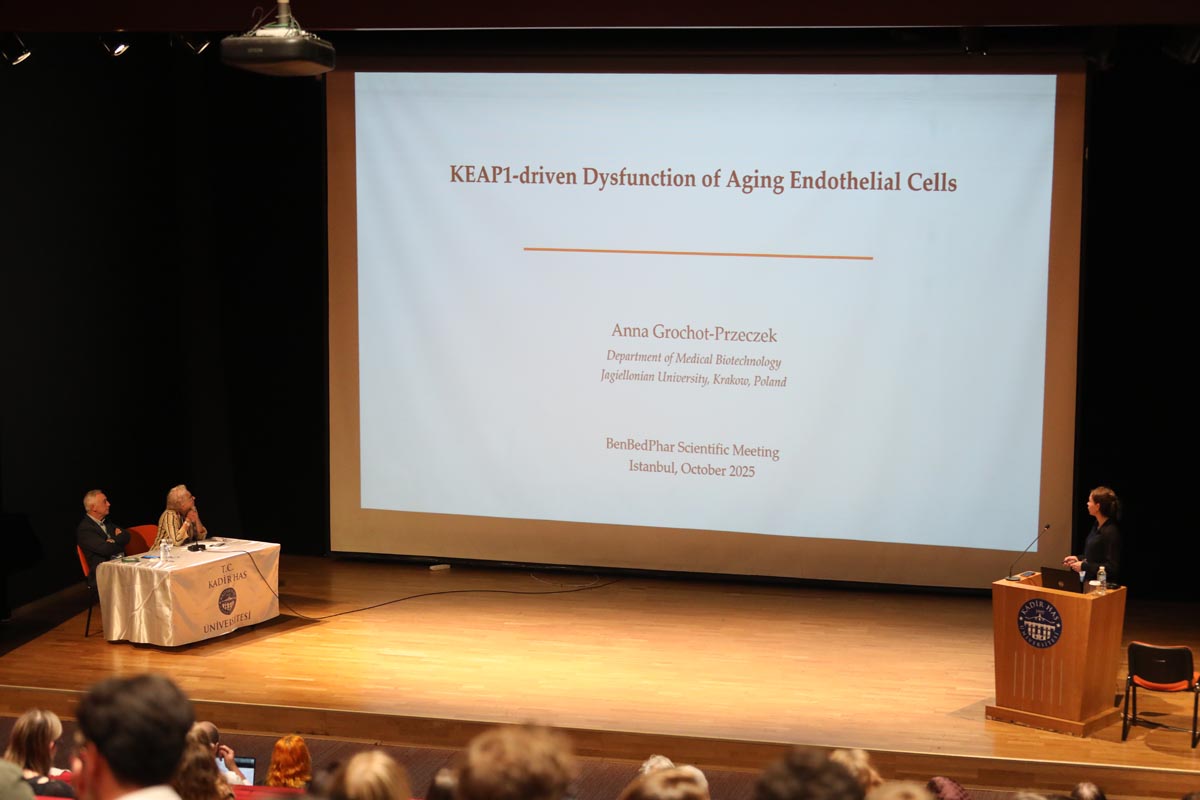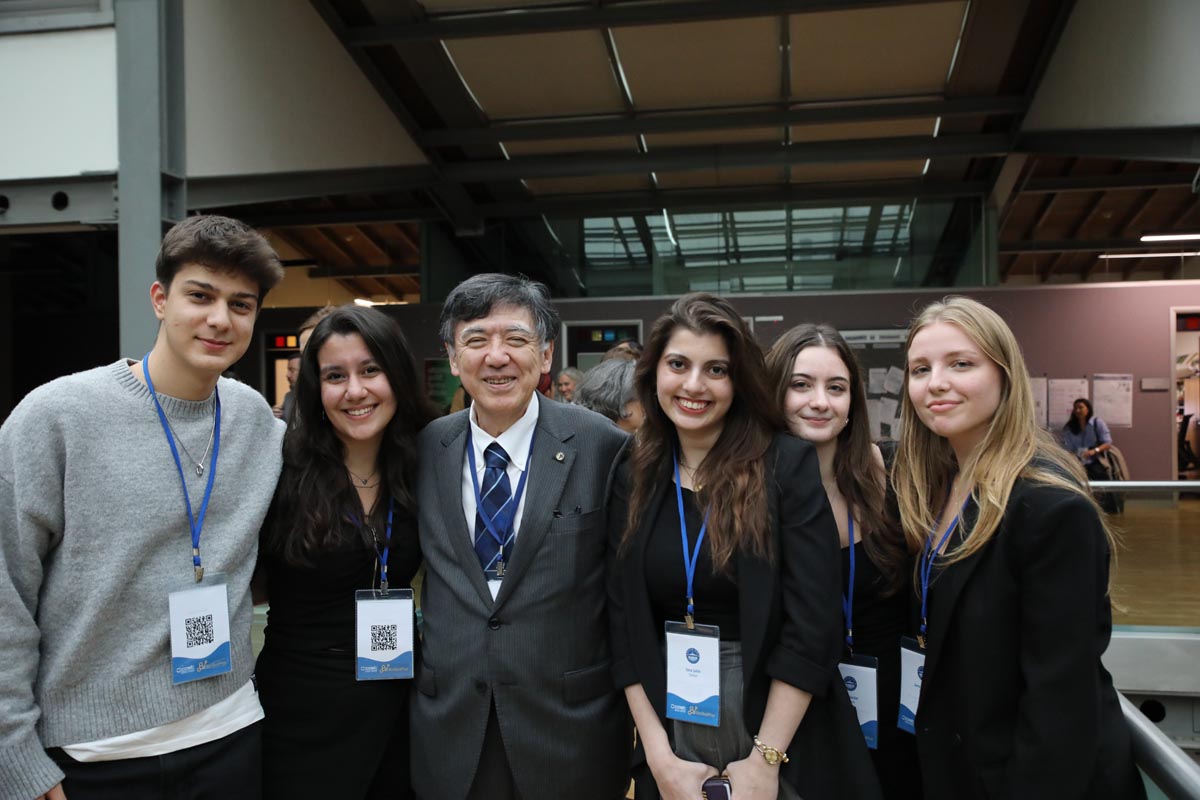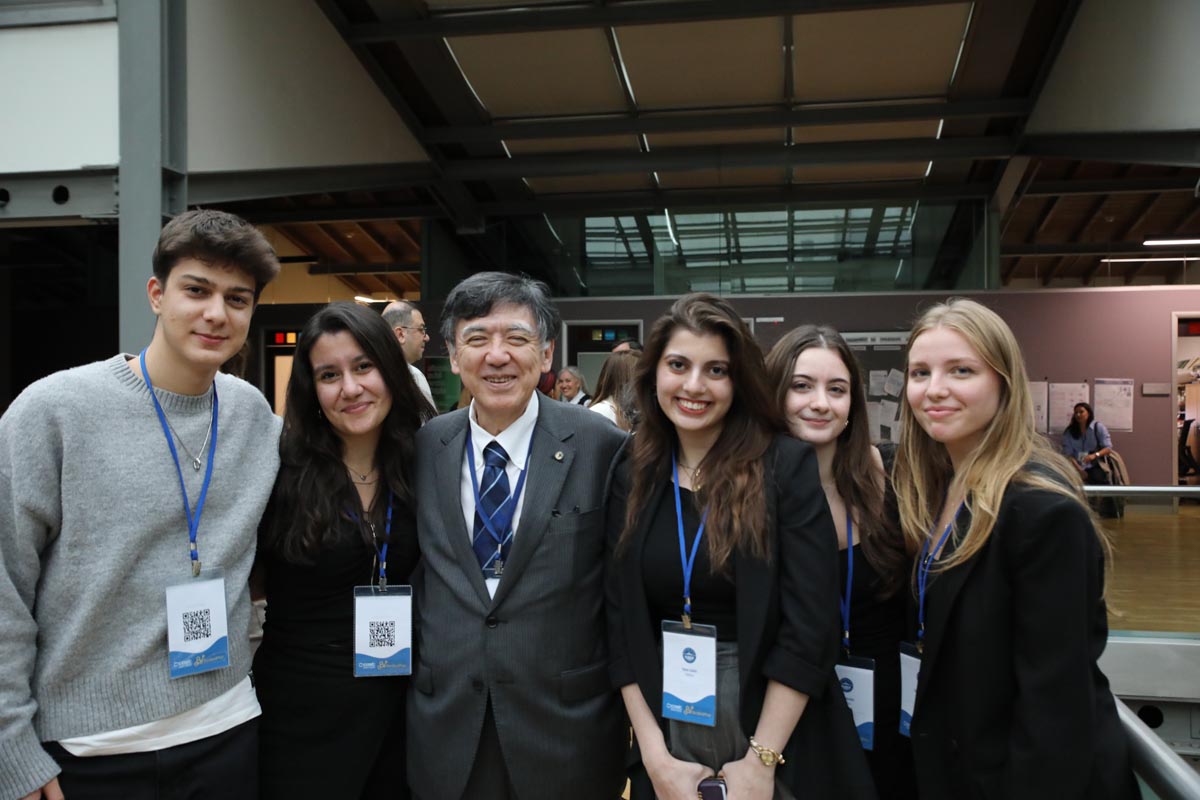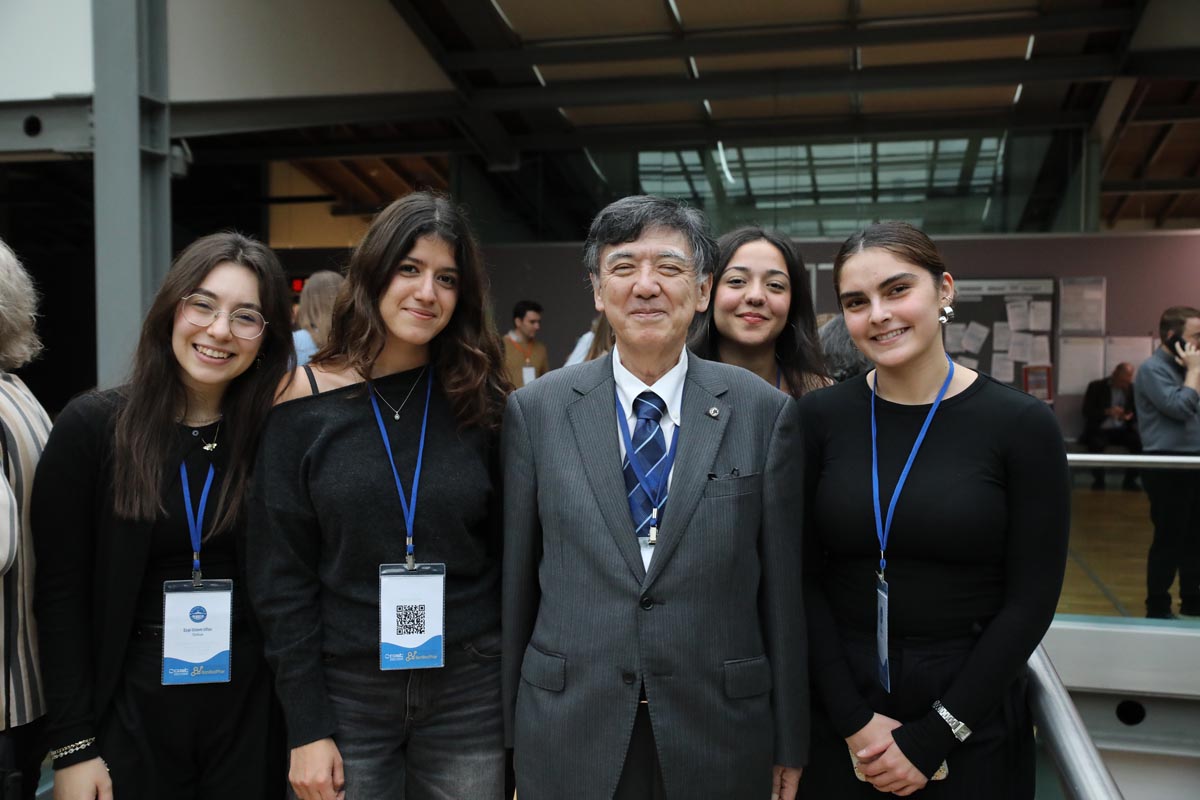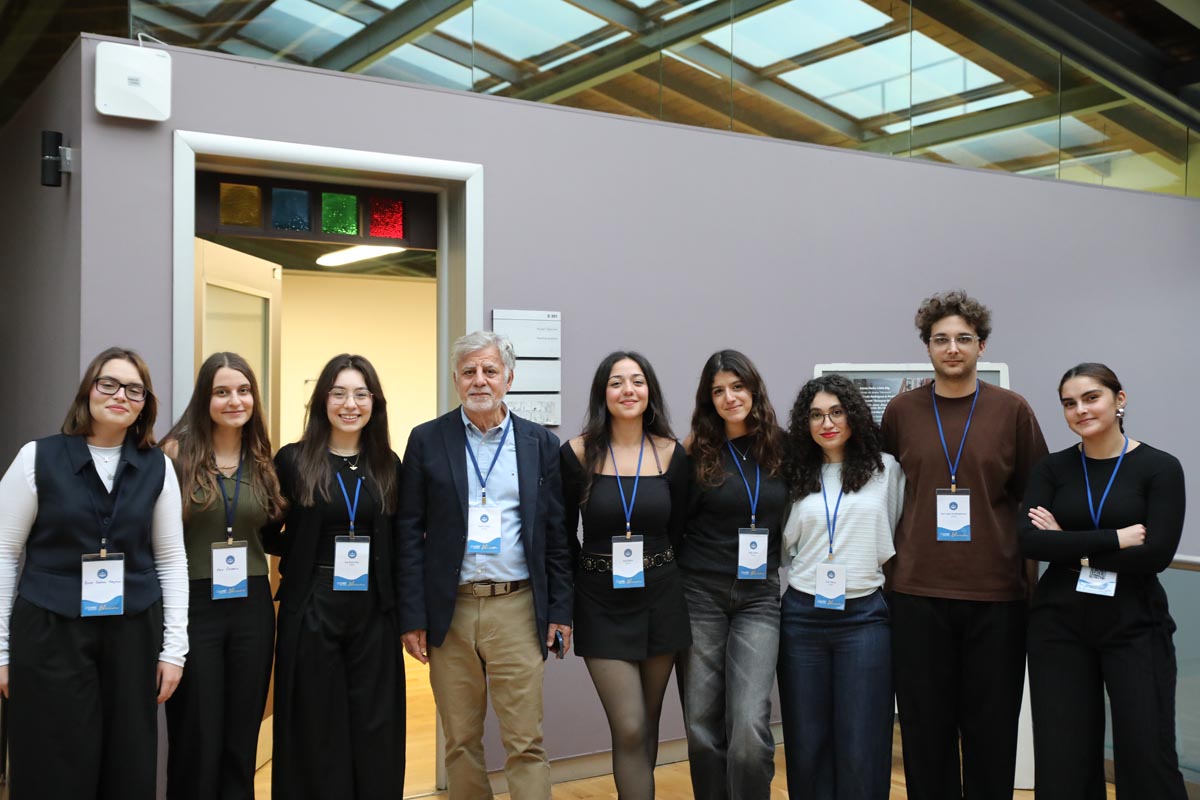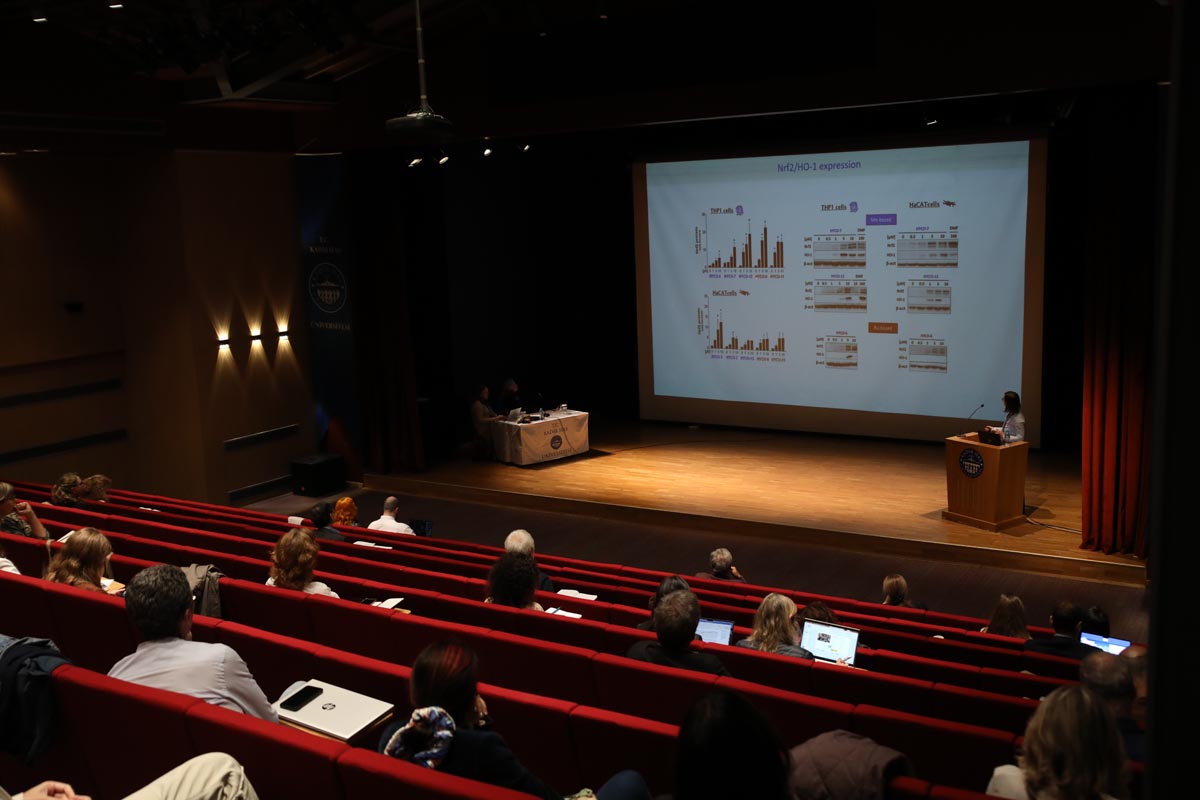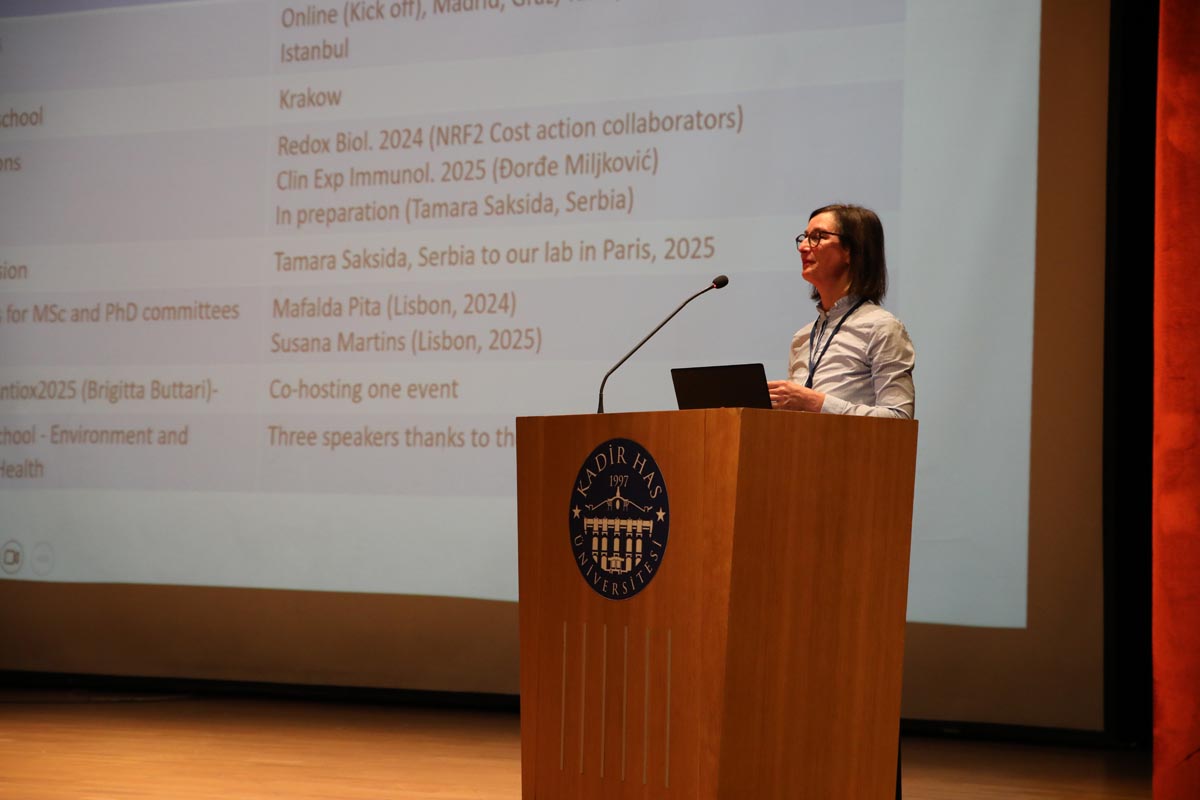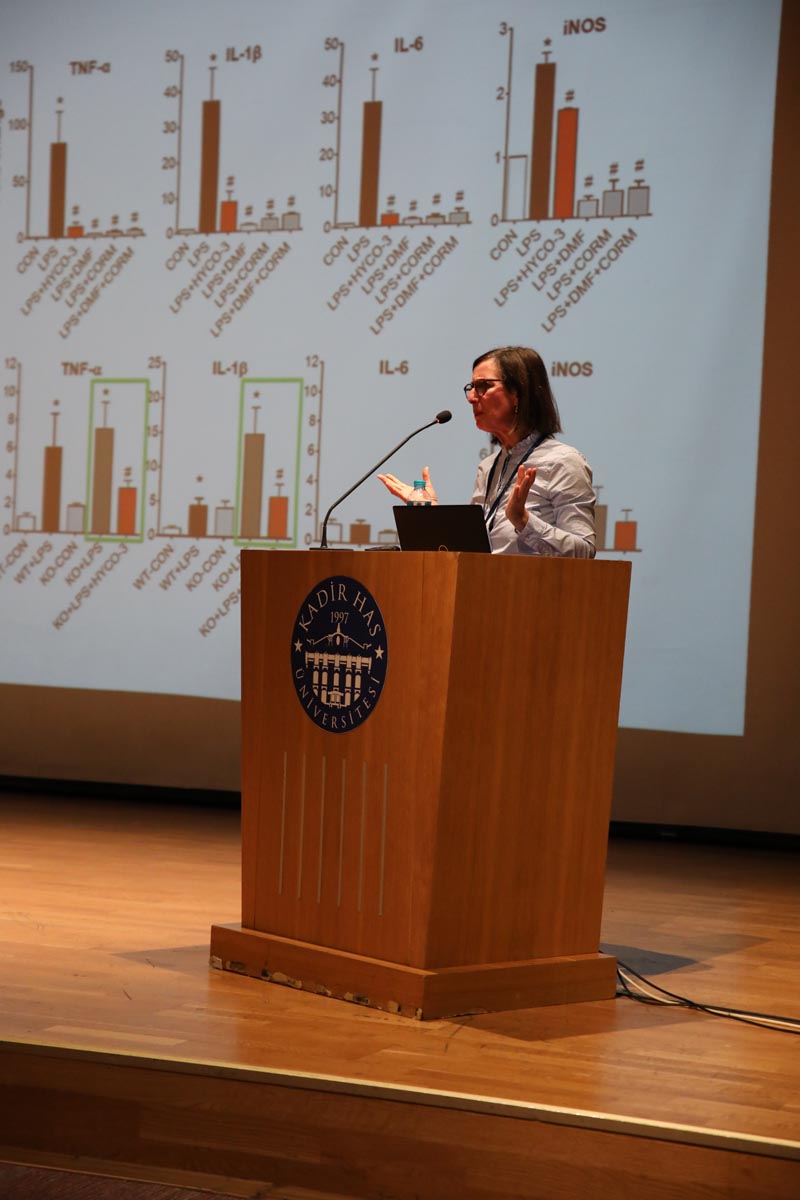Thursday 9th of October
- 14:00 – 14:15 Welcome and Introduction. Kemal Yelekci, Gina Manda, and Antonio Cuadrado
- 14:15 – 16:45 Scientific Session I Chairs: Antonio Cuadrado and Gina Manda
O1: The KEAP1-NRF2 Pathway: From Cancer Chemoprevention to Cancer Progression
Masayuki Yamamoto
Tohoku University, Tohoku Medical Megabank Organization
We have identified the KEAP1-NRF2 system, which senses environmental stresses and activate cellular defense responses. NRF2 is a transcription factor that plays a crucial role in the coordinated expression of cellular defense enzymes against oxidative and electrophilic stresses. KEAP1 acts as a sensor for these stresses and continuously promotes the degradation of NRF2. Nrf2 gene knockout animals are highly sensitive to a wide variety of toxic electrophiles and reactive oxygen species, whereas Keap1 gene knockdown animals exhibit a gain-of-function phenotype characterized by enhanced NRF2-mediated cytoprotection. Genetic as well as pharmacological inductions of NRF2 protect our body from the oxidative and electrophilic injury. We have demonstrated the benefits of NRF2 activation in various disease models. Notable examples of the activity include the cancer chemoprevention and protection against space-related stresses. In contrast, cancer cells frequently hijack NRF2 activity, leading to NRF2-hyperactivated (or -addicted) cancers. Such NRF2-addicted cancers are refractory to standard radio-chemotherapy and are associated with poor prognosis. Recent structure-function analyses of KEAP1 have advanced our understanding of this system and opened the way for developing NRF2-activating cytoprotective agents as well as NRF2-inhibiting anti-cancer drugs. Research on the KEAP1-NRF2 system is also expanding into human biology utilizing the Tohoku Medical Megabank cohort study and into space mouse biology utilizing the International Space Station. Both historical contexts and recent advancements in the KEAP1-NRF2 field will be discussed.
O2: Title: In Memoriam: Thomas W. Kensler, PhD (1948–2025)
Dionysios V. Chartoumpekis
Division of Endocrinology, Department of Internal Medicine, School of Medicine, University of Patras, Greece
It is with deep sadness that I share the passing of Thomas Wells Kensler, PhD, professor emeritus and pioneering cancer prevention researcher, who died on July 11, 2025, at the age of 76 following a hiking accident on Mont Blanc in France. Born in New York City in 1948, Tom grew up in Lexington, Massachusetts, attended Buckingham Browne & Nichols School, earned an AB in biology from Hamilton College, and completed his PhD in toxicological sciences at MIT in 1976. Following postdoctoral training at the University of Wisconsin and the National Cancer Institute, Tom joined the faculty of the Johns Hopkins Bloomberg School of Public Health in 1980, where he rose to professor and directed the Division of Toxicological Sciences. He later held appointments at the University of Pittsburgh and the Fred Hutchinson Cancer Center in Seattle, retiring in 2024.Renowned for his groundbreaking research in cancer chemoprevention, including nutrition-based strategies such as broccoli sprout interventions in China, Tom received many honors. Yet he valued most his role as a mentor. I was fortunate to be both his mentee and friend. His open-mindedness and example showed me how to pursue basic research on the Keap1/Nrf2 pathway while also striving toward clinical impact.
A passionate mountaineer and kayaker, Tom explored all seven continents and every U.S. state. He is survived by his wife of 43 years, Dr. Nancy E. Davidson, their children Kevin and Caroline, and extended family. Tom will be deeply missed, and for me, he will always be an inspiration in science and in life.
O3: KEAP1-driven Dysfunction of Aging Endothelial Cell
Milena Cichoń, Aleksandra Kopacz, Damian Klóska, Alicja Józkowicz, Anna Grochot-Przęczek
Jagiellonian University, Faculty of Biochemistry, Biophysics and Biotechnology, Department of Medical Biotechnology, Kraków, Poland
Cardiovascular diseases (CVDs) are the leading cause of death globally. Endothelial cells (ECs) that line the inner surface of blood and lymph vessels pay critical role in maintaining healthy phenotype of vasculature. Aging dysregulates function of ECs which contributes to a higher risk of CVDs in the elderly. Our data suggest that NRF2 and KEAP1 can be involved in this process.
KEAP1 (Kelch-like ECH-associated protein 1) is a redox-sensitive repressor of NRF2 (NFE2L2 – nuclear factor (erythroid-derived 2)-like 2) – a transcription factor that mediates the protective response against oxidative stress. But, as we recently proposed, KEAP1 can act independently from NRF2 and along with nitric oxide synthase (NOS) and transnitrosating protein GAPDH be involved in the formation of S-nitrosothiols, leading to changes in protein function. In NRF2-deficient ECs this leads to the accumulation of protein aggregates, loss of function and premature senescence. Our data show that with age NRF2 level decreases in ECs, which suggests that the same dysfunctional phenotype of ECs can be occurring in physiological aging. Therefore, we study the relation between protein aggregation and cell function in young and aged human-derived primary endothelial cells with the possible involvement of S-nitrosation mediated by KEAP1/NOS/GAPDH SNO complex. Our results indicate that a higher level of protein aggregates appears with age along with the impairment of function, which can be restored by the modulation of KEAP1. This suggests a critical NRF2-independent role of this protein in ECs aging.
O4: NRF2 Transcription Factor: Sculpting Synaptic Lipids for Brain Health.
Daniel Carnicero-Senabre; Mariana A Barata; José Jiménez-Villegas; Cláudia Guimas Almeida; Antonio Cuadrado and Ana I. Rojo
Autonomous University of Madrid
Synaptic loss is a key factor in the cognitive decline observed during aging and in neurodegenerative diseases such as dementia, where synaptopathy plays a central role in hippocampal dysfunction. In this study, we investigated the role of NRF2, a master regulator of cellular homeostasis, in maintaining synaptic integrity. We assessed synaptic contacts both in vitro and in vivo and found that NRF2 deficiency leads to a significant reduction in vGLUT1 levels, accompanied by a decrease in the number of synaptic contacts. Because synapses are subject to highly dynamic membrane remodeling processes, we analyzed the lipid composition of hippocampi and synaptosomes from NRF2-deficient and wild-type mouse littermates. Our results revealed an accumulation of ether-linked phospholipids in NRF2-deficient mice. When primary neuronal and organotypic cultures were exposed to an ether-lipid precursor, synaptic density decreased. By contrast, the NRF2 activator 6-MSITC prevented synaptic loss. Although ether lipids are abundant components of neuronal membranes, their specific role in synaptic function and in age-related loss of homeostatic balance remains poorly understood. This study is the first to demonstrate that NRF2 plays an essential role in preserving synaptic homeostasis through lipid metabolism, suggesting its relevance in the context of aging and neurodegenerative diseases.
O5: Oxidative stress response failure in HCC development
Manuela Hidalgo, Yolanda Olmos, María Monsalve
Instituto de Investigaciones Biomédicas Sols-Morreale (CSIC-UAM)
Context: Liver steatosis is a highly prevalent condition associated with the metabolic syndrome that can progress to Metabolic Dysfunction-Associated Steatotic Liver Disease (MASLD), that can, in turn, lead to the development of cirrhosis and Hepatocellular Carcinoma (HCC). The determinant features of this progression are unclear and the condition does not have effective treatment options. In view of the well described presence of mitochondrial oxidative stress associated to MASLD, we decided to evaluate the contribution of impaired mitochondrial function to MASLD progression to HCC. Methodology Approach: We compared disease progression in WT and PGC-1 α KO mice. PGC-1α is a master regulator of oxidative metabolism and PGC-1α deficient mice are a mouse model for the loss of metabolic plasticity and mitochondrial oxidative stress. WT and KO 12 week-old mice were fed with normal or high-fat diet, and treated or not with teratogens (T) for 24 weeks. Results: Weight gain follow up showed that animals treated with HFD+T gained less weight that single treated animals, and the effect was significantly more marked in KO mice. Histology analysis of liver samples showed that liver fat accumulation was, as previously described lower in KO mice tan in WTs but more importantly HFD+T mice had lower levels of fat accumulation than HFD mice and again the effect was higher in KO mice. Disease development was confirmed by evaluation of tumor burden, that was significantly higher in KO mice than in WT mice. Enhanced tumor burden in double treated KO mice was not associated to higher proliferation rates, nor higher levels of fibrosis, but with reduced cell death rates despite increased oxidative stress levels related to failure to induce antioxidant and detoxification systems in KO mice. Conclusions: These results support the hypothesis that mitochondrial dysfunction plays a key role in the HCC and indicate that PGC-1α deficiency is linked to higher levels of oxidative stress and failure to induce cell death pathways leading to HCC.
- 16:45 – 17:15 Coffee and Poster viewing
- 17:15 – 17:45 Scientific Session II Chairs: Anna Grochot-Przeczek and Isabel Lastres-Becker
O6: Role of NRF2 in Reprogramming Glucose Metabolism in Hepatocellular Carcinoma
Young-Joon Surh
College of Pharmacy, Seoul National University
Hypoxia-inducible factor-1α (HIF-1α) and nuclear factor erythroid 2-related factor 2 (NRF2) are constitutively overactivated in hepatocellular carcinoma (HCC). In the present study, we investigated their possible complementary roles in growth and progression of HCC and underlying molecular mechanisms. While silencing HIF-1α in HepG2 human hepatoma cells did not alter the protein expression of NRF2, NRF2 knockdown markedly reduced the nuclear accumulation of HIF-1α without influencing its mRNA expression. In diethylnitrosamine-induced murine hepatocarcinogenesis, there was elevated NRF2 expression with concomitant upregulation of HIF-1α. NRF2 and HIF-1α co-localize and physically interact with each other. In addition, the interaction between NRF2 and HIF-1α was found in specimens obtained from HCC patients. In normoxia, HIF-1α undergoes hydroxylation by a specific HIF-prolyl hydroxylase domain protein (PHD), which facilitates ubiquitination and proteasomal degradation of HIF-1α. However, direct interaction with NRF2 hampers the PHD2-mediated hydroxylation and subsequent recruitment of von-Hippel-Linda for ubiquitination of HIF-1α. This results in the prolonged stabilization of HIF-1α, even in the presence of oxygen (pseudohypoxia), which may account for the HIF-1α -mediated aerobic glycolysis (Warburg effect).
O7: Aberrant BACH1/Nrf2 axis in Down Syndrome brain contributes to early onset Alzheimer-like neuropathology
Sara Pagnotta, Antonella Tramutola, Eugenio Barone, Fabio di Domenico and Marzia Perluigi
Department of Biochemical Sciences, Sapienza University of Rome
Several studies support the implication of aberrant redox phenotype in the brain of people with Down Syndrome (DS). Indeed, by mapping chromosome 21 several genes, such as SOD-1, BACH1, APP, CBR and S100B, are involved in the over-production of ROS in DS individuals. In particular, we investigated the role of BACH1 in the brain and its implication in the failure of the antioxidant response and autophagy system in human autoptic cases and in a mouse model of DS (Ts2Cje). Our results revealed that BACH1 overexpression impairs the BACH1/NRF2 ratio in the nucleus as well as the induction of antioxidant response genes and a number of autophagic genes ultimately resulting in the accumulation of oxidative damage. Recent evidences on neurons and astrocytes isolated from Tg mice suggest that these processes act in concert to cause cell death via ferroptosis. Our findings suggest that BACH1 triplication in DS subjects modulate multiple downstream targets that altogether might contribute to accelerate the neurodegenerative process, ultimately resulting in early onset Alzheimer disease.
O8: Screening natural products for the identification of NRF2 activity modulators
Despoina D Gianniou1, Ioanna Kentroti1, Ioannis P. Trougakos1,2
1 Faculty of Biology, National and Kapodistrian University of Athens, Athens, Greece
2 GenCell-TSBiotech (https://gencell.gr/), Athens, Greece
Aging is a complex biological process caused by the time-dependent loss of cellular homeodynamics and consequently of physiological organismal functions. This process is affected by both genetic and environmental (e.g., diet) factors, as well as by their constant interaction. The balanced functionality of (among others) cellular antioxidant, mitostatic and proteostatic modules is central to genome, mitochondrial and proteome stability. The antioxidant response system comprising the ubiquitously expressed NFE2-related transcription factor 2 (NRF2) and its redox-sensitive cytoplasmic inhibitor Kelch-like ECH-associated protein 1 (KEAP1) defends tissues against (among others) oxidative stress, thereby protecting against pathologies that relate to cellular biomolecules damage. We have shown the dose- and tissue-dependent activity of the NRF2/KEAP1 regulatory network during lifetime, as well as that NRF2 is part of a longevity promoting circuit that ensures functional wiring of proteostatic and mitostatic modules and consequently organismal survival during stress. We have also found a cytoprotective role of NRF2 in various age-related degenerative diseases, as well as that selected natural products can have a positive impact on cellular functionality, also via the activation of the NRF2 pathway, strongly supporting the notion that they can act as potential aging preventive agents and/or therapeutics for age-related disorders. Our rational and experimental platforms (both cell-free and cell-based, as well as at in vivo experimental models) for identifying modulators of NRF2 activity with anti-ageing and/or anti-age-related diseases (e.g., neurodegeneration, etc.) activity, along with some relevant recent findings, will be presented. Acknowledgments: IPT thanks NKUA SARG (C.S. 19067) for support.
O9: Identification of Novel Keap1 Inhibitors Using Machine Learning, Molecular Modeling and Molecular Dynamics Simulations.
Kemal Yelekçi, Alp Eren Kazar, Ceren Cebeci
Kadir Has University, Faculty of Engineering and Basic Sciences, Department of Molecular Biology and Genetics, Fatih, Istanbul, Türkiye
The structure of human Keap1 Kelch domain (PDB: 4IFN) was retrieved from the protein data bank. The dataset of Keap1 inhibitors was downloaded from the CheMBL website (https://www.ebi.ac.uk/chembl/) with their respective IC50 values and SMILES codes. First, the compounds were desalted by the “SaltRemover” function of RDKit. The compounds having null IC50 values were eliminated. Also, the compounds having duplicate IC50 values were removed as well. The threshold for IC50 values was determined to be 50 mM. The compounds with IC50 values equal to or lower than 50 μM were classified as” active”, while those with the greater IC50 values were classified as “inactive”. At the end, a set of suitable compounds was left for feature selection and model building. A molecular descriptors/features calculator called “PaDEL” was installed to identify specific descriptors such as hydrogen bond donor, hydrogen bond acceptor, molecular weight, Lipinski, SLogP value, Rotatable bond, and TopoPSA. Two-dimensional descriptors and fingerprints were calculated based on the SMILES of all compounds. The descriptors contain the computed features’ specific topological and physicochemical properties by assigning a quantitative value for each feature.
The compounds were split into a training and test set for model building and evaluation. Feature selection was applied, and a refined set of molecular features was obtained using PaDEL as the descriptor program. Using the Matthew correlation coefficient, a training set, a test set, and a mean value have been determined for random forest model building. The most effective classification algorithm was generated for handling datasets requiring only a ligand SMILES string as input for rapid screening against the Keap1 target. Additionally, molecular docking studies and molecular dynamics simulations were used to analyze the most potent compounds’ interactions with Keap1, thus evaluating the most stable ligand–Keap1 complexes. This novel framework aims to provide a fast, novel, and generalizable approach for predicting diverse compounds to be used as an inhibitor for Keap1.
Conflict of interest: None
Acknowledgments: AEK thanks TÜBİTAK (PN: 2209) for support.
Friday 10th of October
- 09:00 – 11:00 Session III Chairs: Ana I. Rojo and Albena Dinkova-Kostova
O10: Activation of Nrf2 Signaling and Inflammation Reduction by Dietary Broccoli Sprouts in Cafeteria Diet-Fed Mice
Marian V. Ivanochko, Maria M. Bayliak, Dmytro V. Gospodaryov, Volodymyr I. Lushchak
Department of Biochemistry and Biotechnology, Vasyl Stefanyk Precarpathian National University, 57 Shevchenko Str., Ivano-Frankivsk, 76018, Ukraine
Introduction. Nuclear factor erythroid 2-related factor 2 (Nrf2) is a key regulator of antioxidant defense, xenobiotic detoxification, and proinflammatory processes. Nrf2 activators, such as sulforaphane found in broccoli sprouts (BS), are being studied for their potential therapeutic roles in managing obesity and its associated metabolic complications. Materials and methods. This study examined the effects of dietary BS supplementation on the activities of Nrf2 target enzymes in the liver and cerebral cortex of eight-month-old C57BL/6J male mice reared on an obesogenic cafeteria diet (CD). Mice were fed for 16 weeks on one of four diets: 1) standard rodent feed (control), 2) standard feed with 5% of three-day-old BS, 3) CD, or 4) CD with 5% BS (CD+BS). Results. BS supplementation resulted to higher in-gel activities of glutathione S-transferases alpha and pi, and glutathione peroxidase in the murine liver compared to the control and mice fed CD. The activity of glutathione reductase was the highest in mice fed CD+BS. In the cerebral cortex, activities of glutathione reductase, glucose 6-phosphate dehydrogenase, and NAD(P)H-quinone oxidoreductase 1 were most elevated in the CD+BS group. Additionally, CD feeding significantly raised hepatic mRNA levels of genes CCL2 and IL6, markers of inflammation. In contrast, BS and CD+BS diets upregulated PPARGC1A, which encodes PGC-1α, a master regulator of mitochondrial biogenesis and anti-inflammatory pathways downstream of Nrf2 signaling. Conclusions. These findings highlight the potential of BS supplementation to activate Nrf2-dependent antioxidant responses and attenuate obesity-induced inflammation in the murine liver and brain.
O11: Towards (marine) nutraceutical based ferroptosis intervention strategies to support aging healthcare
Wim Vanden Berghe
University Antwerp, Cell Death Epigenetic Signaling Lab
Non-canonical Nrf2-dependent ferroptosis is a specific type of programmed cell death where a cell dies because its membrane is attacked by oxidative rust and disintegrates. In recent years, ferroptosis manifests across a spectrum of maladies with profound implications for human well-being. Numerous investigations substantiate that modulating ferroptosis, whether through inhibition or augmentation, plays a pivotal role in the etiology and control of numerous age-related afflictions, encompassing metabolic, cardiovascular, oncological, respiratory, neurological disorders and infectious diseases.
To better discriminate between biological and pathophysiological aging processes, by a dynamic interplay of metabolic, genetic, epigenetic, environmental, nutritional (diet) and microbiomal factors, we apply multi-omic ferroptosis signature approaches to define epigenetic age acceleration as a prognostic health-disease risk biomarker.
(Marine) plants possess primitive defense mechanisms, being in an early stage of evolution and lacking an immune system like ours. Instead of white blood cells, they rely on oxidative iron metabolic responses for defense. This ancient mechanism is also found in marine organisms such as seaweeds and algae, which lack immune systems and are packed with healthy antioxidants, minerals and vitamins to manipulate oxidative rusting ferroptosis systems to survive. We envision translational prospects of potential green-blue biotechnological applications of ferroptosis-targeted (marine) nutraceutical interventions to support aging healthcare.
O12: NRF2 signaling emerges as a key mediator in the molecular interplay between defective proteostasis and metabolic dysfunction in neurodegeneration
Fabio Di Domenico
Department of Biochemical Sciences, Sapienza University of Rome
Disruption of protein homeostasis (proteostasis) is increasingly recognized as a central factor in neurodegeneration, linking protein misfolding, oxidative stress, and cellular toxicity. Our research shows that disturbances in cellular stress response pathways, particularly the unfolded protein response (UPR), are closely associated with impairments in the NRF2-mediated antioxidant defense system. Concurrently, metabolic dysfunction correlates with proteostasis disruption and influences NRF2 signaling, together contributing to cognitive deficits. Using both in vitro and in vivo models, we investigated how metabolic stress impacts proteostasis and redox balance through the modulation of NRF2 activity. Furthermore, we demonstrate that pharmacological targeting of proteostasis or metabolically-driven stress responses can reduce oxidative damage and improve cellular resilience by restoring NRF2 function. These findings suggest that metabolic imbalance can intensify proteostasis failure and redox dysregulation, promoting neurodegenerative changes and cognitive decline. NRF2 emerges as a critical effector in coordinating cellular damage and repair mechanisms. Targeting these interconnected pathways, particularly through the modulation of NRF2 and restoration of redox homeostasis, may offer promising therapeutic strategies for neurodegenerative disorders.
O13: Pharmacological Inhibition of Nrf2 as a Strategy to Overcome Therapy Resistance in Cancer
Srđan Bjedov
Faculty of Sciences, University of Novi Sad, Serbia
Aberrant activation of the Nrf2 (nuclear factor erythroid 2–related factor 2) signaling pathway has emerged as a major mechanism by which cancer cells evade therapeutic stress. While Nrf2 plays a protective role in normal cells by regulating antioxidant and detoxification genes, its persistent upregulation in tumors—often due to mutations in KEAP1 or NFE2L2—drives drug resistance, metabolic adaptation, and immune escape. This presentation explores the therapeutic potential of pharmacologically inhibiting Nrf2 in cancers characterized by redox imbalance and resistance to standard treatments. I will outline current strategies for small-molecule inhibition of Nrf2, including direct inhibitors (e.g., ML385, PhcY), indirect Keap1-stabilizing agents (e.g., K67), and upstream modulators derived from natural products (e.g., apigenin, brusatol). Mechanistic insights, molecular targets, and efficacy data from preclinical studies will be highlighted, alongside challenges such as toxicity, off-target effects, and delivery barriers. Special attention will be given to the rationale for Nrf2 inhibition in non-small cell lung cancer, hepatocellular carcinoma, and breast cancer, where restoring therapy sensitivity through redox disruption has shown promising results. Finally, I will discuss emerging directions such as PROTACs, combination therapies with chemotherapy and immunotherapy, and biomarker-based patient stratification. Targeting the Nrf2 pathway represents a novel and underexplored approach to dismantling cancer’s adaptive shield—offering new hope for tackling treatment-resistant malignancies.
- 11:00 – 11:30 Coffee and Poster viewing
- 11:30 – 13:30 Session III
O14: Sex-Specific Differences in NRF2-Driven Stress Responses and Autophagy in MASLD and MASH Models: Toward Tailored Therapeutic Approaches.
Marta Alegret1,2,3, Núria Roglans1,2,3, Jianing Zhou Wu1, Yanhao Qiu1, Elisabetta Profumo4, Alessandra Berry5, Letizia Giona5, Luciano Saso6, Brigitta Buttari4*
1Department of Pharmacology, Toxicology and Therapeutic Chemistry, School of Pharmacy and Food Science, University of Barcelona, Barcelona, Spain;
2Institute of Biomedicine, University of Barcelona, Barcelona, Spain;
3Spanish Biomedical Research Centre in Physiopathology of Obesity and Nutrition (CIBEROBN), Instituto de Salud Carlos III (ISCIII), Madrid, Spain;
4Department of Cardiovascular and Endocrine-metabolic Diseases and Aging, Istituto Superiore di Sanità, Rome, Italy;
5Center for Behavioural Sciences and Mental Health, Istituto Superiore di Sanità, 00161 Rome, Italy;
6Department of Physiology and Pharmacology “Vittorio Erspamer”, Sapienza University, Rome, Italy.
Sex differences play a key role in the development and severity of Metabolic Dysfunction-Associated Steatotic Liver Disease (MASLD) and its progression to Metabolic Dysfunction-Associated Steatohepatitis (MASH), conditions linked to metabolic syndrome, obesity, and type 2 diabetes. The issue of sex-differences in the context of hepatic steatosis
and NRF2-dependent proteostatic control is particularly worthy of investigation, as most preclinical studies have primarily focused on male models. This study aimed to investigate how sex influences the NRF2-mediated oxidative stress response, autophagy, unfolded protein response (UPR) signaling, and inflammatory markers in rats subjected to chronic metabolic challenges. Two dietary models were used over 12 weeks: a High-Fat and High-Fructose (HFHFr) diet to mimic MASLD, and a Choline-Deficient, L-Amino Acid-Defined (CDAA) diet to model MASH. The HFHFr diet primarily induced fatty liver and early-stage steatosis in females, whereas the CDAA diet led to steatohepatitis, fibrosis, and more advanced liver pathology in males. During the early stages of MASLD, males exhibited more effective NRF2-driven antioxidant defenses and autophagy-mediated proteostasis, while females showed reduced autophagic activity, potentially due to altered KEAP1-NRF2 regulation. In the advanced MASH model, despite similar NRF2 and KEAP1 transcript levels between sexes, CDAA-fed males displayed elevated inflammatory markers (e.g., TNF-α, F4/80), impaired autophagy, and an attenuated IRE1-XBP1 response. These findings highlight sex-specific differences in NRF2 signaling, autophagy, and ER stress responses during MASLD/MASH progression, underscoring the importance of sex-informed, NRF2-centered therapeutic strategies for chronic liver diseases.
O15: NRF2 as a Key Regulator in Intestinal Inflammation Induced by Silver Nanoparticles and its Modulation with quercitin.
Adelaide Sousa, Inês Santos, Rui Fernandes, Sofia Pacheco, Félix Carvalho, Eduarda Fernandes, Marisa Freitas
Laboratory of Applied Chemistry, Department of Chemical Sciences, Faculty of Pharmacy, University of Porto, 4050-313 Porto, Portugal
Prolonged oral exposure of silver nanoparticles (AgNP) may result in significant accumulation in intestinal cells, potentially triggering inflammation, oxidative stress, and cytokine release. This study investigated the effects of polyvinylpyrrolidone (PVP)-coated AgNP of two distinct sizes (5 and 50 nm) on intestinal epithelial C2BBe1 cells, with a focus on nuclear factor erythroid 2-related factor 2 (NRF2) and nuclear factor kappa-light-chain-enhancer of activated B cells (NF-κB) expression, as well as the production of reactive nitrogen species. Additionally, the potential protective effect of quercetin, a flavonoid renowned for its antioxidant properties, was evaluated. Exposure to both sizes of PVP-AgNP resulted in a significant downregulation of NRF2 expression, as evidenced by decreased levels of p-NRF2. Both AgNP’ sizes activated the NF-κB pathway, leading to increased levels of cyclooxygenase-2 (COX-2), prostaglandin E2 (PGE2), and pro-inflammatory cytokines. Notably, activation mechanisms differed between the two sizes: the smaller nanoparticles (5 nm) activated NF-κB via the p65 pathway, whereas the larger nanoparticles (50 nm) triggered its activation through the IκBα-dependent pathway. Additionally, both sizes induced a significant upregulation of inducible nitric oxide synthase (iNOS) expression and nitric oxide (●NO) production. Quercetin exhibited protective effects, particularly in cells exposed to 5 nm PVP-AgNP. It restored NRF2 expression, reduced iNOS levels, and significantly lowered ●NO production. Furthermore, quercetin decreased PGE2 and IL-8 production, highlighting its protective role in modulating inflammation and nitrosative stress. These findings suggest that targeting NRF2 pathways could offer a promising approach for preventing or treating inflammation-related disorders in the intestinal epithelium caused by nanoparticle exposure.
O16: Repurposing Omaveloxolone as a potential therapeutic approach for Early Age-Related Macular Degeneration
Ana S. Falcão*, Margarida Pedro, Shuvajit Rakshit, Luisa Lemos, Pedro Antas, Sandra Tenreiro and Miguel C. Seabra
NOVA Medical School, Universidade Nova de Lisboa, Lisboa, Portugal
Age-related macular degeneration (AMD) is characterized by progressive degeneration of the retinal pigment epithelium (RPE), contributing to photoreceptor loss and vision impairment. To model early AMD pathology, we established an in vitro system in which human RPE cells are challenged with porcine photoreceptor outer segments (POS), leading to lysosomal dysfunction and accumulation of autofluorescent granules (AFGs) that resemble lipofuscin deposits observed in vivo. These undigested materials are thought to drive oxidative stress and impair RPE viability. In parallel, we are validating an in vivo mouse model of AMD using a single intraperitoneal injection of sodium iodate (NaIO₃), which selectively targets RPE cells and induces oxidative stress. This model recapitulates key AMD features, including increased fundus autofluorescence, retinal thinning, and focal RPE cell loss followed by photoreceptor degeneration. NRF2 is a master regulator of antioxidant defense, inflammation, and autophagy. Given the central role of oxidative stress in AMD, we investigated the therapeutic potential of Omaveloxolone (OMV), an FDA-approved NRF2 activator, in our AMD models. The in vitro results demonstrate that OMV reduces AFG accumulation in POS-fed RPE cells and induces NRF2 protein expression within 2 hours of treatment, followed by upregulation of its downstream targets, HO-1 and NQO1. Preliminary in vivo data show that OMV prevents NaIO₃-induced retinal thinning and preserves RPE electrical activity. These findings support the repurposing of NRF2 activators such as OMV as a promising therapeutic strategy to preserve RPE function and slow AMD progression, particularly in early or intermediate stages where no approved treatments are currently available.
Project funded by “La Caixa Foundation” (NASCENT HR22-00569), R&D unit [iNOVA4Health] (UIDB/04462/2020 and UIDP/04462/2020) and LS4FUTURE Associated Laboratory (LA/P/0087/2020) funded by FCT.
O17: NRF2 induction coupled with cellular delivery of carbon monoxide for counteracting inflammatory conditions
Roberta Foresti
Faculty of Health, University Paris-Est Créteil, INSERM U955, Créteil, France
NRF2 is a fundamental stress responsive transcription factor that controls the expression of several antioxidant and inflammation-related genes, including heme oxygenase-1 (HO-1). The main function of HO-1 is to degrade heme to carbon monoxide (CO) and biliverdin/bilirubin that are downstream effector molecules possessing protective and signaling properties, partially explaining the beneficial consequence of NRF2 activation. A variety of cellular pathways underlie the development but also in the rescuing of many chronic diseases. Therefore we hypothesized that creating hybrid compounds (HYCOs) consisting of CO-releasing molecules conjugated to NRF2 inducers could represent an advantageous approach to counteract conditions that are characterized by inflammation and oxidative stress. We synthesized and studied several HYCOs that were tested in cells and in vivo models with interesting results. Selected HYCOs, especially those containing Mn-based CO-releasing molecules, caused a significant increase in intracellular CO and augmented NRF2/HO-1 in different cell types. HYCOs reduced markers of inflammation in inflammatory cells challenged with LPS, while they decreased damage and myoglobin release in cardiomyocytes subjected to hypoxia-reoxygenation. Different HYCOs used in vivo modulated inflammation in models of LPS, psoriasis and multiple sclerosis, decreasing IL-8 production, erythema and scaling cores in psoriasis and the clinical manifestation of multiple sclerosis when given daily by oral gavage. Interestingly, the effect of these compounds was superior to that of NRF2 inducers or CO-releasing molecules alone.
Thus, developing dual activity molecules that activate NRF2 transcription and mimic HO-1-derived CO is a promising strategy for application in conditions where inflammation and oxidative stress are predominant features.
- 13:30 - 14:30 Lunch and Poster viewing
- 14:30 - 16:30 Session IV Chairs: Christina Morgenstern and Silvia Giordani
O18: Dissecting the protein interactome of wild type and lung cancer associated gain-of-function mutant forms of NRF2
Anna-Liisa Levonen
University of Eastern Finland
Gain-of-function (GOF) mutations in NRF2 are frequently observed in squamous cell lung cancer and are associated with poor patient prognosis due to resulting NRF2 hyperactivation. These mutations are typically localized in two hotspot regions within the KEAP1-interacting DLG and ETGE motifs of NRF2, leading to impaired ubiquitination, decreased degradation, and consequent stabilization of the protein. Although NRF2 is recognized as a key oncogenic transcription factor, its protein interaction network remains poorly characterized, largely due to the inherent challenges of transcription factor proteomics. In this study, we investigated the interactome of wild-type NRF2 and two GOF mutants, D29N and E79Q, located within the DLG and ETGE domains, respectively. We employed proximity-dependent biotin identification (BioID) combined with mass spectrometry to map protein-protein interactions. Additionally, we integrated chromatin immunoprecipitation sequencing (ChIP-seq) and RNA sequencing (RNA-seq) to assess changes in chromatin binding and gene expression. Proteomic analysis revealed that GOF mutants of NRF2 translocate to the nucleus and associate with chromatin more robustly than wild-type NRF2. BioID profiling identified several known NRF2 interactors, such as KEAP1, MAFG, and PGAM5, alongside a set of novel binding partners. Notably, the GOF mutations of NRF2 significantly enhanced interactions with chromatin-associated proteins, including components of the SWI/SNF chromatin remodeling complex, as well as various transcriptional coactivators and coregulators. These altered interactions were reflected in widespread changes in NRF2 chromatin occupancy and downstream target gene expression. We propose that oncogenic NRF2 mutations promote cancer progression by enhancing its engagement with chromatin-modifying proteins, thereby reshaping the epigenetic landscape to drive oncogenic transcriptional programs.
O19: Dual Modulation of NRF2 by KEAP1 and GSK3: A Shared Therapeutic Axis in Alzheimer’s Disease and MASH
Raquel Fernández-Ginés, Marta Olazabal, José Jiménez-Villegas, Daniel Carnicero Senabre, Ángel J. García-Yagüe, Ana I. Rojo and Antonio Cuadrado
Department of Biochemistry, Faculty of Medicine, Autonomous University of Madrid, Madrid,Spain.
Glycogen synthase kinase-3 (GSK3) is a central kinase implicated in diverse pathologies, ranging from Alzheimer’s disease (AD) to non-alcoholic steatohepatitis (NASH/MASH). In AD, hyperactivation of GSK3 drives tau hyperphosphorylation and neurofibrillary tangle formation, while in NASH, GSK3 contributes to hepatocellular injury, inflammation, and fibrosis. A common downstream target of GSK3 is the transcription factor NRF2, a master regulator of the antioxidant response. NRF2 stability is controlled by two complementary degradation systems: the canonical KEAP1–Cul3 axis and the alternative GSK3–β-TrCP pathway. In early disease states, oxidative stress disables KEAP1, permitting NRF2 activation as an adaptive response. However, in advanced disease, hyperactive GSK3 phosphorylates NRF2, promoting β-TrCP-mediated ubiquitination and proteasomal degradation, thereby silencing cytoprotective transcriptional programs. This mechanistic convergence suggests that dual inhibition of KEAP1 and GSK3 could restore NRF2 function across disease stages. 6-(Methylsulfinyl)hexyl isothiocyanate (6-MSITC, hexarafane), a naturally occurring isothiocyanate, exerts such dual activity: it disrupts KEAP1-dependent repression while simultaneously limiting GSK3-mediated NRF2 degradation. Thus, 6-MSITC provides a conceptual therapeutic bridge between neurodegeneration and metabolic liver disease, offering stage-independent reactivation of NRF2 signaling. Exploring this dual regulatory axis may open new avenues for interventions that simultaneously target redox imbalance, inflammation, and maladaptive protein phosphorylation across seemingly distinct chronic disorders.
O20: Targeting NF-κB–Mediated Neuroinflammation to Recalibrate NRF2 Signaling and Mitigate Oxidative and Ferroptotic Stress in Parkinson’s Disease
Lilia A. Smith1,2, Ignacio Silva-Llanes1,2, Enrique Madruga3,4, Daniel Flores-Téllez1,2, Virginia Solar-Fernández1,2, Alfonso García-Rubia3, Carmen Gil3,4, Ana Martínez,3,4, Isabel Lastres-Becker1,2,4*
1Instituto de Investigaciones Biomédicas “Sols-Morreale” CSIC-UAM, Madrid, Spain.
2Instituto de Investigación Sanitaria La Paz (IdiPaz), Madrid, Spain.
3 Centro de Investigaciones Biológicas Margarita Salas (CSIC), Madrid, Spain
4Centro de Investigación Biomédica en Red, Área Enfermedades Neurodegenerativas, CIBERNED, Instituto de Salud Carlos III, 28029, Madrid, Spain.
Parkinson’s disease (PD) is marked by dopaminergic neurodegeneration, chronic neuroinflammation, oxidative stress, and disrupted proteostasis. NF-κB is a central transcription factor driving the pro-inflammatory cascade in PD, and its sustained activation perpetuates glial reactivity, inflammasome assembly, and cytokine release, further aggravating neuronal injury. Here, we show that pharmacological inhibition of serum- and glucocorticoid-regulated kinase 1 (SGK1) with the novel brain-penetrant compound EMM-3.20 effectively suppresses NF-κB signaling in an α-synuclein overexpression mouse model of PD. This suppression normalizes the expression of NLRP3 inflammasome components, reduces astrogliosis and microgliosis, and attenuates pro-inflammatory cytokine production. Importantly, dampening NF-κB–driven neuroinflammation also modulates the NRF2 antioxidant pathway, as evidenced by the reversal of α-synuclein–induced upregulation of NRF2 and its target genes (Hmox1, Nqo1, Gpx1), indicating reduced oxidative stress demand. NRF2-linked processes, including regulation of ferroptosis, lipid peroxidation, and mitochondrial homeostasis, were also favorably impacted, suggesting a broad restoration of redox balance. Together, these findings reveal that targeting NF-κB–mediated inflammatory signaling upstream can indirectly recalibrate NRF2 activity and its protective transcriptional program, thereby mitigating oxidative, ferroptotic, and mitochondrial stress. This NF-κB–NRF2 axis modulation via SGK1 inhibition emerges as a promising disease-modifying strategy for PD and related neurodegenerative disorders with intertwined inflammatory and oxidative pathology.
O21: Nrf2 Signaling as a Mediator/ Enhancer of Statin- and SGLT2 Inhibitor Benefits in Metabolic Disease
Eleftherios Bochalis and Dionysios V. Chartoumpekis
Department of Internal Medicine, Division of Endocrinology, University of Patras, Greece
The transcription factor Nrf2 integrates cytoprotective functions with regulation of key metabolic pathways, including gluconeogenesis and lipogenesis. While its activation protects against hyperglycemia, fatty liver, and insulin resistance, its modulation by frontline metabolic disease drugs is poorly characterized.
We examined Nrf2 pathway activation by two major drug classes—statins and SGLT2 inhibitors—widely prescribed for dyslipidemia and diabetes.
In male Wistar rats (n=5), simvastatin (120 mg/kg/day, 5 days, gavage) significantly increased hepatic Nrf2 transcriptional activity and upregulated target gene expression (EMSA). This was confirmed in primary hepatocytes and the ST2 cell line, revealing cholesterol-independent but mevalonate-dependent mechanisms.
In wild-type C57Bl/6 male mice, chronic canagliflozin treatment (200 mg/kg chow) was assessed in two settings: a longevity study (n=175; 83 control, 92 canagliflozin) and a 3-month exposure study (n=25). Canagliflozin extended median survival by 5 weeks (112.5 vs 107.5 weeks, p<0.05). Transcriptomic analysis in the short-term cohort revealed robust Nrf2 pathway activation in liver and adipose tissue. These findings suggest that Nrf2 signaling may mediate—and potentially amplify—the beneficial effects of statins and SGLT2 inhibitors. Targeting Nrf2 alongside these treatments could yield additive or synergistic benefits. Ongoing work in Nrf2 knockdown models will clarify its causal role in drug action. (In loving memory of my mentor, Thomas W. Kensler.
- 16:30 - 17:00 Lunch and Poster viewing
- 17:00 - 19:00 Session IV Chairs: Santiago Cuevas and Irina Milisav
O22: Nrf2 in MASH; Potential Role of Lipid Droplet Maturation
Bengu Cetinkaya1, Tugce Demirel-Yalciner2,3, Nesrin Kartal Ozer2,3
1Department of Biochemistry, Faculty of Medicine, Marmara University, Istanbul, Türkiye
2Department of Biochemistry, Faculty of Medicine, Uskudar University, Istanbul, Türkiye
3Metabolic and Inflammatory Diseases Research Center (METIFLAM), Uskudar University, Istanbul, Türkiye
Metabolic dysfunction-associated steatotic liver disease (MASLD) has emerged as the most widespread chronic liver condition, starting with simple hepatic steatosis that can progress to metabolic dysfunction-associated steatohepatitis (MASH), and hepatic fibrosis. Lipid droplets (LDs) are ubiquitous organelles not only specialized in lipid storage, but also participate in inflammatory and metabolic dieases. Regarding the crucial role of LD accumulation in MASH development, understanding signaling mediators regulating LD biogenesis may give alternate views on disease pathogenesis and treatment approaches. Nrf2 is a major transcription factor that plays a pivotal role in regulating the response against oxidative stress and inflammation. Although it is known to involve in MASH development, how Nrf2 signaling is affected in LD biogenesis is not yet clear.
In our study, we established an in vivo MASH model in mice fed cholesterol-, palmitate-, trans fat-rich diet, and reduced LD biogenesis by specifically inhibiting the hepatic Seipin expression using metabolically stable siRNAs that are conjugated to a synthetic N-acetylgalactosamine (GalNAc). Focusing on alterations in disease development, we tested Nrf2 status and LD biogenesis in our in vivo disease model. Our initial finding point out both Nrf2 and Seipin protein as an emerging parameters to involve in the transition from steatosis to MASH. Further studies include the role of hepatic Seipin inhibition in MASH development together with Nrf2 status. Overall, our findings could represent a novel interaction between LD biogenesis and Nrf2 that wll contribute to treatment approaches against MASH. Supported by The Scientific And Technological Research Council Of Turkey (TUBITAK) 223S770.
O23: The thyroid as a sentinel and target organ in Keap1/Nrf2 pathway activation: lessons from animal models and human studies, and implications for Nrf2-targeted therapies.
Panos G. Ziros, Georgios Psarias, Dionysios V. Chartoumpekis, Gerasimos P. Sykiotis
Service of Endocrinology, Diabetology & Metabolism, Lausanne University Hospital & University of Lausanne, Lausanne, Switzerland
Hormonal systems interact with stress signaling pathways to maintain homeostasis throughout life. In vertebrates, the thyroid gland is central to metabolic regulation, controlling oxygen consumption and resting energy expenditure via secretion of thyroxine (T4) and triiodothyronine (T3). Thyroid hormone synthesis requires hydrogen peroxide dependent oxidation reactions that iodinate thyroglobulin (TG), the hormone precursor. Evidence from mice and humans demonstrates a tight link between the Keap1/Nrf2 antioxidant pathway and thyroid physiology, including direct Nrf2 mediated transcriptional control of TG via two AREs. Keap1 hypomorphic mice, with constitutively active Nrf2, develop goiter and mild biochemical hypothyroidism but show no extra thyroidal defects under normal conditions. Similarly, a heterozygous KEAP1 loss of function mutation in a Japanese family segregated with goiter over five generations without other phenotypes. These findings identify the thyroid as highly sensitive to genetic Nrf2 activation and raise potential clinical concerns for Nrf2 modulating drugs. Pharmacological Nrf2 activation might induce goiter, while inhibition could enhance oxidative stress sensitivity, favoring autoimmune thyroid disease — a possibility supported by NRF2 promoter polymorphisms linked to thyroid autoimmunity. Future work should determine whether post natal Nrf2 activation alone causes goiter, and whether dietary or environmental factors modulate Keap1/Nrf2 dependent thyroid phenotypes. Preclinical testing of clinically used Nrf2 modulators and monitoring patients for thyroid effects are warranted. At this closing meeting of the BenBedPhar COST Action, we present completed and preliminary studies on Keap1 hypomorphic mice, discuss goiter pathogenesis, and outline future collaborative research arising from the Action.
O24: Nrf2 is a transcriptional regulator of CD5L
Sharadha Dayalan Naidu, Elena V. Knatko and Albena T. Dinkova-Kostova
University of Dundee, United Kingdom
CD5 antigen-like (CD5L), also known as apoptosis inhibitor expressed by macrophages (AIM), is a protein, which is secreted by macrophages and participates in multiple biological processes, including inflammation and infection. CD5L can be transcriptionally upregulated by liver X receptor-a (LXRa)/retinoid X receptor (RXR) complex, MafB, sterol regulatory element-binding protein 1a (SREBP-1a), and signal transducer and activator of transcription 3 (STAT3). A comparative analysis of the proteomes of bone marrow-derived macrophages (BMDMs) from wild-type (WT), Nrf2-knockout (Nrf2-KO) and Keap1-knockdown (Keap1-KD) mice identified CD5L among the differentially abundant proteins, where in comparison with WT BMDMs, the copy number of CD5L was higher in Keap1-KD and lower in their Nrf2-KO counterparts. A follow-up study showed that genetic or pharmacological activation of Nrf2 increased the mRNA levels of CD5L, similar to the classical Nrf2 target NAD(P)H: quinone oxidoreductase 1 (NQO1). Conversely, depletion of Nrf2 resulted in a decrease in CD5L mRNA levels. Moreover, the potency of small-molecule Nrf2 activators with distinct mechanisms of action and potencies, correlated with the extent of CD5L expression, both at the mRNA and the secreted protein levels. The induction of CD5L by the Nrf2 activator omaveloxolone was also observed in primary human macrophages. CRISPR/Cas9 gene editing-mediated deletion of two sequences resembling the antioxidant response element (ARE) Nrf2-binding motif, located 20,000 bp upstream of the Cd5l promoter, led to a profound decrease in CD5L mRNA levels. Together, these findings identify Nrf2 as a transcriptional regulator of CD5L.
O25: Vascular effects of dimethyl fumarate in male hereditary hypertriglyceridemic rats exposed to social stress
Iveta Bernatova, Peter Balis, Aybuke Bozkurt, Andrea Micurova, Michal Kluknavsky
Centre of Experimental Medicine, Institute of Normal and Pathological Physiology, Slovak Academy of Sciences, Bratislava, Slovakia
Hypertriglyceridemia and chronic social stress are recognized risk factors for cardiometabolic disorders. We investigated vascular function in adult male normotensive male Wistar-Kyoto (WKY), borderline hypertensive (BHR), and hypertriglyceridemic (HTG) rats. The effects of chronic crowding stress and the NRF2 activator dimethyl fumarate (DMF; 20 mg/kg/day, p.o., 4 weeks) on vascular function in HTG rats were also examined. BHR and HTG rats exhibited elevated blood pressure and augmented noradrenaline- and K⁺-induced contractions in femoral (FA) and mesenteric (MA) arteries vs. WKY. In HTG, but not BHR, acetylcholine (ACh)-induced relaxation was impaired in both arteries, while plasma triglycerides, atherogenic index, and glycemia were increased. In HTG, social stress significantly potentiated maximal K⁺- and serotonin-induced FA constrictions. MA responses were unaltered. DMF reduced K⁺- and noradrenaline-induced MA, but not FA, contractions. In addition, stress diminished ACh-induced relaxation in the FA and DMF failed to restore it. In MA, stress and DMF interacted significantly: the lowest ACh-induced relaxation occurred in DMF-treated HTG rats exposed to stress. DMF also elevated expression of Nfe2l2, Hmox1, and Ppara genes in the heart. In conclusion, hypertriglyceridemia with prehypertension exerted more detrimental vascular effects than prehypertension alone. While DMF selectively attenuated K⁺- and noradrenaline-induced contractions in HTG rats, DMF did not improve, and, under stress conditions, it even exacerbated endothelial dysfunction in the MA. The results thus indicate caution when DMF is used due to its effects on vascular function, especially under conditions of metabolic dysregulation or chronic stress. Supported by APVV-22-0296 and MVTS-CA20121.
- 19:00 – 19:15 Farewell Kemal Yelekci, Gina Manda, and Antonio Cuadrado

